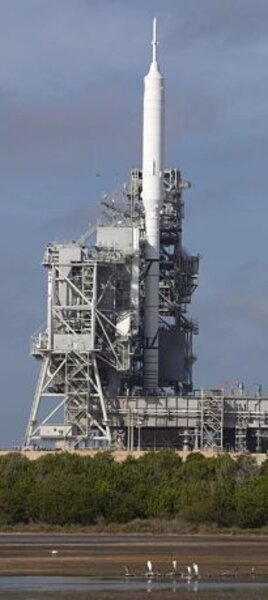The NASA Ares 1-X rocket is set for launch -- but watch those clouds!
Loading...
What's nearly twice as tall as the space shuttle plus boosters and tank, is NASA's current best hope for replacing the shuttles, and may not launch as planned tomorrow?
Yep, it's the Ares 1-X. Any delay has nothing to do with hardware -- so far so good on that score. The uncertain cloud on the horizon is the weather. But it's getting better.
Over the weekend, the mission's weather watcher Kathy Winters pointed to a 60 percent chance that the weather wouldn't cooperate. The forecast for launch time tomorrow morning (8:00 a.m. Eastern Daylight Time) still suggests a 60 percent chance that the weather will violate the mission's launch requirements.
Those requirements have undergone some changes over the past few years. One provision launch directors now have to deal with: The risk that the rocket will plow through clouds on its way up and smack into cloud droplets.
Those collisions build a charge of static electricity on the outside of the rocket. For those of you who want to wow (or maybe ward off) someone at the next party you attend, drop the phrase "tribo electrification rule." That's what they call this rocket version of static cling.
That electric charge can interfere with communications between the rocket and the ground. Since this is a test flight, no one wants anything to block the flow of data from the rocket to eager engineers back at the Kennedy Space Center.
And if the range-safety officer has to blow up the rocket during its ascent because it's misbehaving in ways that threaten life or property, you want to make sure the explosives on the rocket receive the detonation command.
This isn't a concern for the space shuttles. They were designed with this phenomenon in mind. But the Ares 1-X is a different beast, and the rule has come back into play.
The good news: NASA has four hours to get this puppy off the ground. That's a good deal longer than space-shuttle launch windows. The launch window for the last year's Hubble repair mission was 42 minutes. The window for missions to the international space station tend to last about 5 minutes.
The difference? Timing gets quite precise when you're aiming to rendezvous with something else in space. But the Ares 1-X mission involves a quick up-and-down suborbital trip.
That four-hour window actually gives launch directors some leeway in dealing with problems that might crop up. And it gives them latitude to waiting for a break in any cloud cover big enough to thread the rocket through.
And if not a Tuesday launch? Look for another attempt at the same time on Wednesday. The weather looks better for that day – only a 40 percent chance it will violate launch requirements. After then, it's off to the negotiating table to haggle with other customers waiting to use launch facilities at the Kennedy Space Center.





